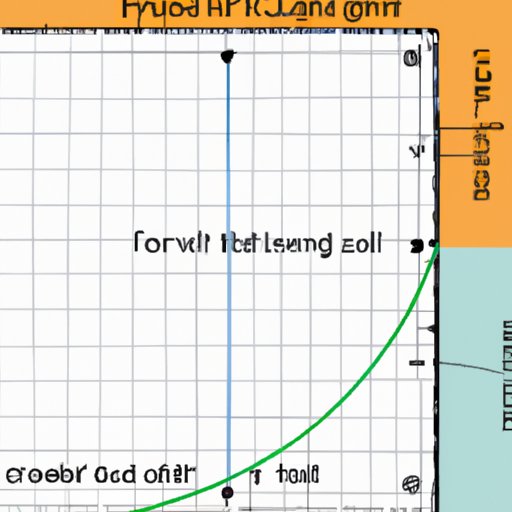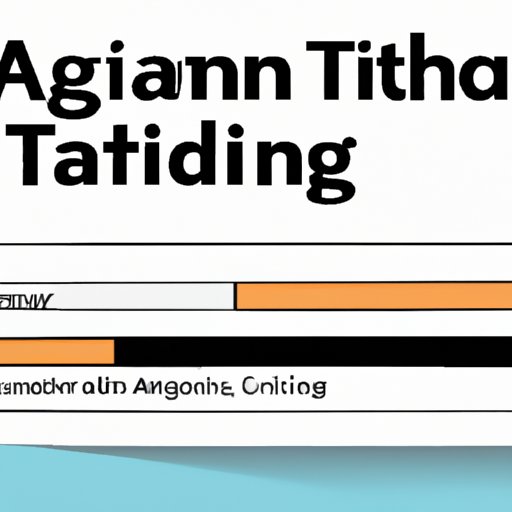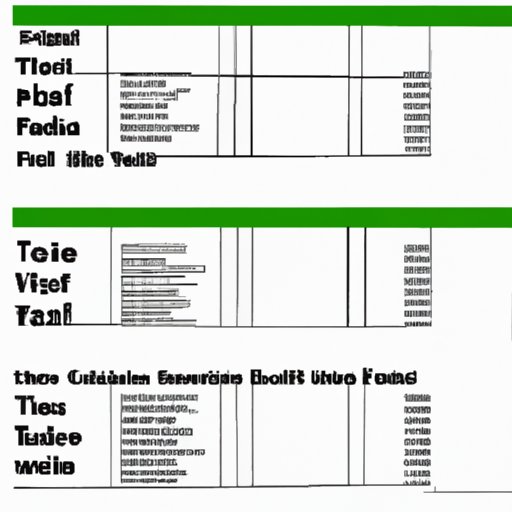Introduction
Have you ever encountered the issue where the text you typed into an Excel cell just won’t fit within its confines? This is a common problem for most Excel users, and it can be quite frustrating when you’re trying to keep your spreadsheet neat and organized. Fortunately, there are several options available to help you properly format Excel cells to fit text.
The purpose of this article is to provide a comprehensive guide on how to format Excel cells to fit text. We will go over various methods, such as utilizing the “Wrap Text” option, adjusting cell height and width, merging cells, using Shrink to Fit, applying a text alignment format, limiting text length with Data Validation, and taking advantage of Conditional Formatting.
Utilizing the “Wrap Text” Option
The “Wrap Text” option is a simple yet effective way to make sure that your text fits within an Excel cell. With this feature, the text will expand to fit the width of the cell, and then wrap onto the next line, allowing it to fit within the confines of the cell.
Steps to Activate
To use the “Wrap Text” option, simply select the cells that you want to apply the format to, and then click on the “Wrap Text” button located in the Alignment section of the Home tab. Alternatively, you can press Ctrl + 1 to open the Format Cells window, and then check the “Wrap Text” box.
Benefits
Using the “Wrap Text” option is a great way to quickly and easily format your text to fit within an Excel cell. It also allows you to keep your spreadsheet looking neat and organized, as the text will automatically wrap onto the next line instead of spilling over into other cells.

Adjusting Cell Height and Width
Another way to format Excel cells to fit text is by manually adjusting the cell height and width. This method is particularly useful if you need to adjust the size of multiple cells at once.
Steps to Activate
To adjust the cell height and width, select the cells that you want to modify, and then click on the “Format” button located in the Cells section of the Home tab. From there, you can adjust the cell height and width by entering the desired values in the appropriate fields.
Benefits
Manually adjusting the cell height and width is a great way to ensure that your text fits within the confines of a cell without having to rely on the “Wrap Text” option. It also allows you to quickly and easily adjust the size of multiple cells at once.
Merging Cells
If you need to fit a large amount of text into a single cell, merging multiple cells together can be a great solution. By doing so, you can create a larger cell that can accommodate more text.
Steps to Activate
To merge cells, select the cells that you want to merge, and then click on the “Merge & Center” button located in the Alignment section of the Home tab. Alternatively, you can press Ctrl + 1 to open the Format Cells window, and then check the “Merge Cells” box.
Benefits
Merging cells is a great way to fit a large amount of text into a single cell. It is also a great way to create a larger cell that can accommodate more information or data.
Using Shrink to Fit
The “Shrink to Fit” option is another great way to make sure that your text fits within an Excel cell. With this feature, the font size of the text will be automatically reduced in order to fit the width of the cell.
Steps to Activate
To use the “Shrink to Fit” option, simply select the cells that you want to apply the format to, and then click on the “Shrink to Fit” button located in the Alignment section of the Home tab. Alternatively, you can press Ctrl + 1 to open the Format Cells window, and then check the “Shrink to Fit” box.
Benefits
Using the “Shrink to Fit” option is a great way to quickly and easily format your text to fit within an Excel cell. It also allows you to keep your spreadsheet looking neat and organized, as the font size of the text will be automatically reduced in order to fit the width of the cell.

Applying a Text Alignment Format
Applying a text alignment format is another effective way to make sure that your text fits within an Excel cell. With this feature, you can choose from several different alignment options, such as left-aligned, center-aligned, or right-aligned.
Steps to Activate
To apply a text alignment format, simply select the cells that you want to apply the format to, and then click on the “Align Left”, “Align Center”, or “Align Right” buttons located in the Alignment section of the Home tab. Alternatively, you can press Ctrl + 1 to open the Format Cells window, and then select the desired alignment option.
Benefits
Using a text alignment format is a great way to make sure that your text fits within an Excel cell. It also allows you to customize the look and feel of your spreadsheet, as you can choose from several different alignment options.
Limiting Text Length with Data Validation
Data validation is a powerful tool that can be used to limit the amount of text that can be entered into an Excel cell. This is especially useful if you want to make sure that the text does not exceed a certain length.
Steps to Activate
To use data validation to limit the amount of text that can be entered into an Excel cell, select the cell that you want to apply the format to, and then click on the “Data Validation” button located in the Data Tools section of the Data tab. From there, you can set the maximum number of characters that can be entered into the cell.
Benefits
Using data validation to limit the amount of text that can be entered into an Excel cell is a great way to make sure that the text does not exceed a certain length. It also allows you to ensure that all of the cells in your spreadsheet have consistent lengths.

Taking Advantage of Conditional Formatting
Conditional formatting is a powerful tool that can be used to visually indicate when the text in a cell exceeds a certain length. This is especially useful if you want to quickly identify which cells have too much text and need to be adjusted.
Steps to Activate
To use conditional formatting to visually indicate when the text in a cell exceeds a certain length, select the cell that you want to apply the format to, and then click on the “Conditional Formatting” button located in the Styles section of the Home tab. From there, you can set the conditions for when the cell should be highlighted.
Benefits
Using conditional formatting to visually indicate when the text in a cell exceeds a certain length is a great way to quickly and easily identify which cells need to be adjusted. It also allows you to keep your spreadsheet looking neat and organized, as the cells that need to be adjusted will be clearly highlighted.
Conclusion
In conclusion, there are several different ways to properly format Excel cells to fit text. Utilizing the “Wrap Text” option, adjusting cell height and width, merging cells, using Shrink to Fit, applying a text alignment format, limiting text length with Data Validation, and taking advantage of Conditional Formatting are all great options for ensuring that your text fits within an Excel cell.
(Note: Is this article not meeting your expectations? Do you have knowledge or insights to share? Unlock new opportunities and expand your reach by joining our authors team. Click Registration to join us and share your expertise with our readers.)
